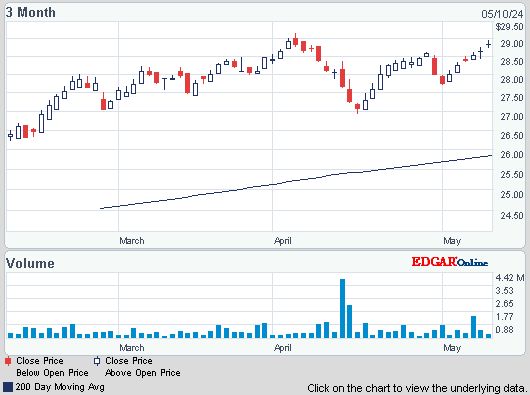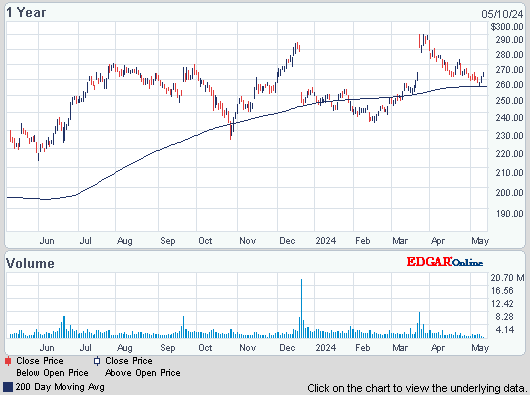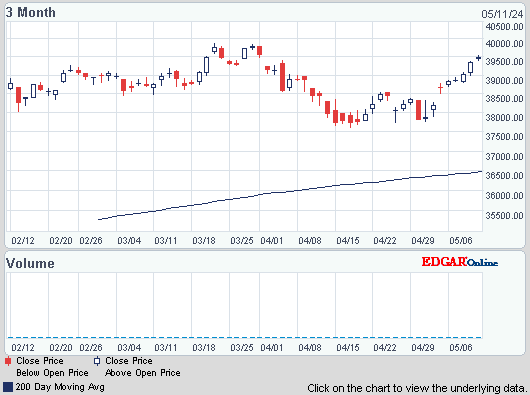Dow was up 16, decliners just ahead of advancers & NAZ fell 5. The Financial Index did little in the 203s. The MLP index fell 3 to 397 & the REIT index was off a fraction in the 268s. Junk bond funds were mixed & Treasuries were up a tad. Oil & gold were even, although oil is pushing on $100 (bad for the economy) & gold is near $1700, a 6 month high.


Photo: Bloomberg
FedEx cut its earnings forecast, putting the blame on a weak global economy. The world's 2nd-biggest package delivery company said the shortfall is primarily in its express division, which moves 3.5M packages on an average day. That indicates customers have continued to switch from overnight air delivery to slower, cheaper methods. Poor economic conditions in Europe & slowing growth elsewhere, including Asia, have forced the shifts. FDX expects EPS of $1.37-$1.43 in its fiscal Q1 that ended Aug 31, down from an original forecast of $1.45-$1.60. Analysts were expecting $1.56. Both FDX & larger rival UPS (UPS) have warned about the impact of slower economic growth on their results. FDX revenue grew just 3% at the express division in Q1. Operating income dropped $148M, largely due to a charge for the retirement of some aircraft, but a 3% decline in package volume also hurt results. The stock is down 1.23, but off its lows.


Photo: Bloomberg
It is being reported that ECB President Mario Draghi's bond-buying proposal involves unlimited purchases of gov debt that will be sterilized to assuage concerns about printing money. Under the blueprint, “Monetary Outright Transactions,” the ECB would refrain from setting a public cap on yields. The plan will only focus on gov bonds rather than a broader range of assets & will target short-dated maturities of up to 3 years. The € jumped half a penny to $1.26. Draghi told the European Parliament this week that the ECB needs to intervene in bond markets to wrest back control of interest rates in the fragmented euro-area economy & ensure the survival of the currency. Policy makers will start deliberating on the plan later today & Draghi will announce results tomorrow. They are likely to adopt the proposal, with Germany's Bundesbank remaining the sole objector.

Photo: Bloomberg
US companies got more output from their workers this spring than initially thought. Productivity rose at a modest 2.2% annual rate in Q2, largely because employers cut back sharply on hiring. The Labor Dept said that productivity in Q2 was better than its initial estimate of a 1.6% gain. The main reason for the increase was the gov revised growth in Q2 to an annual rate of 1.7%, up from an initial estimate of 1.5%. That led to more output, which boosted productivity. Labor costs rose at an annual rate of 1.5%, slightly lower than the 1.7% initially estimated. Rising productivity can boost corp profits. But it can also slow job creation if it means companies are getting more from their current staff & don't need to add workers. Over the past year, productivity has risen 1.2%, far below the 3% average productivity growth turned in during 2009 & 2010. Those gains were a result of massive job layoffs during the recession as companies slashed costs in the face of falling demand.
Productivity in U.S. Grows More Than Previously Estimated
Markets are doing little which is favorable given the downward bias associated with this month. Tomorrow we will hear what the biggies in Europe decide on how to fight their financial problems. From its low at the end of Jul, the € is up a nickel. At least it's slide has ended for the time being. Fri is the big Aug jobs report & expectations are not high. Dow continues to hold above 13K.

AMJ (Alerian MLP Index tracking fund)
Treasury Yields:
U.S. 3-month | 0.101% | |
U.S. 2-year | 0.234% | |
U.S. 10-year | 1.577% |
| CLV12.NYM | ...Crude Oil Oct 12 | ...95.39 | .... | (0.1%) |
| GCU12.CMX | ...Gold Sep 12 | .....1,693.30 | ... | (0.0%) |
Get the latest daily market update below:

FedEx cut its earnings forecast, putting the blame on a weak global economy. The world's 2nd-biggest package delivery company said the shortfall is primarily in its express division, which moves 3.5M packages on an average day. That indicates customers have continued to switch from overnight air delivery to slower, cheaper methods. Poor economic conditions in Europe & slowing growth elsewhere, including Asia, have forced the shifts. FDX expects EPS of $1.37-$1.43 in its fiscal Q1 that ended Aug 31, down from an original forecast of $1.45-$1.60. Analysts were expecting $1.56. Both FDX & larger rival UPS (UPS) have warned about the impact of slower economic growth on their results. FDX revenue grew just 3% at the express division in Q1. Operating income dropped $148M, largely due to a charge for the retirement of some aircraft, but a 3% decline in package volume also hurt results. The stock is down 1.23, but off its lows.
FedEx (FDX)

It is being reported that ECB President Mario Draghi's bond-buying proposal involves unlimited purchases of gov debt that will be sterilized to assuage concerns about printing money. Under the blueprint, “Monetary Outright Transactions,” the ECB would refrain from setting a public cap on yields. The plan will only focus on gov bonds rather than a broader range of assets & will target short-dated maturities of up to 3 years. The € jumped half a penny to $1.26. Draghi told the European Parliament this week that the ECB needs to intervene in bond markets to wrest back control of interest rates in the fragmented euro-area economy & ensure the survival of the currency. Policy makers will start deliberating on the plan later today & Draghi will announce results tomorrow. They are likely to adopt the proposal, with Germany's Bundesbank remaining the sole objector.

US companies got more output from their workers this spring than initially thought. Productivity rose at a modest 2.2% annual rate in Q2, largely because employers cut back sharply on hiring. The Labor Dept said that productivity in Q2 was better than its initial estimate of a 1.6% gain. The main reason for the increase was the gov revised growth in Q2 to an annual rate of 1.7%, up from an initial estimate of 1.5%. That led to more output, which boosted productivity. Labor costs rose at an annual rate of 1.5%, slightly lower than the 1.7% initially estimated. Rising productivity can boost corp profits. But it can also slow job creation if it means companies are getting more from their current staff & don't need to add workers. Over the past year, productivity has risen 1.2%, far below the 3% average productivity growth turned in during 2009 & 2010. Those gains were a result of massive job layoffs during the recession as companies slashed costs in the face of falling demand.
Productivity in U.S. Grows More Than Previously Estimated
Markets are doing little which is favorable given the downward bias associated with this month. Tomorrow we will hear what the biggies in Europe decide on how to fight their financial problems. From its low at the end of Jul, the € is up a nickel. At least it's slide has ended for the time being. Fri is the big Aug jobs report & expectations are not high. Dow continues to hold above 13K.
Dow Jones Industrials
Get your favorite symbols' Trend Analysis TODAY! Click Here


No comments:
Post a Comment